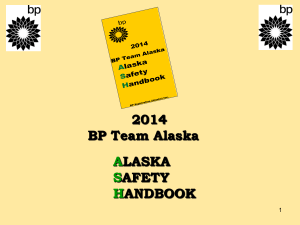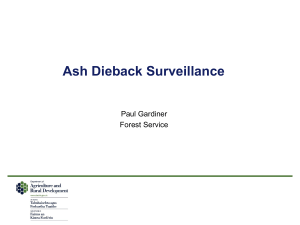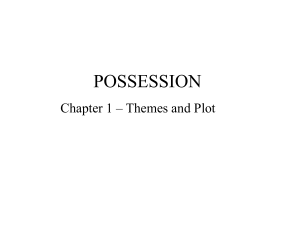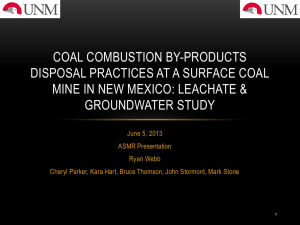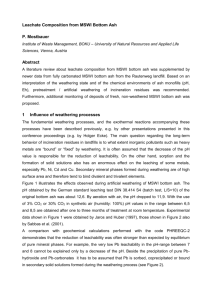Objectives - Deep Blue - University of Michigan
advertisement
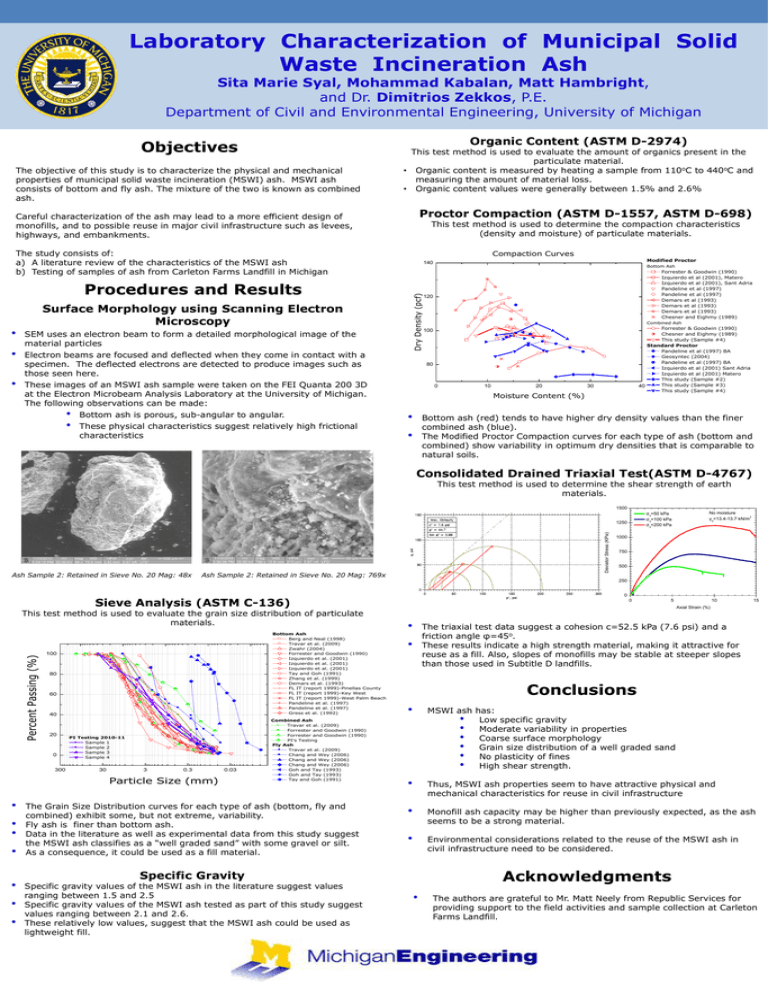
Laboratory Characterization of Municipal Solid Waste Incineration Ash Sita Marie Syal, Mohammad Kabalan, Matt Hambright, and Dr. Dimitrios Zekkos, P.E. Department of Civil and Environmental Engineering, University of Michigan Organic Content (ASTM D-2974) Objectives The objective of this study is to characterize the physical and mechanical properties of municipal solid waste incineration (MSWI) ash. MSWI ash consists of bottom and fly ash. The mixture of the two is known as combined ash. This test method is used to evaluate the amount of organics present in the particulate material. • Organic content is measured by heating a sample from 110oC to 440oC and measuring the amount of material loss. • Organic content values were generally between 1.5% and 2.6% Proctor Compaction (ASTM D-1557, ASTM D-698) Careful characterization of the ash may lead to a more efficient design of monofills, and to possible reuse in major civil infrastructure such as levees, highways, and embankments. This test method is used to determine the compaction characteristics (density and moisture) of particulate materials. The study consists of: a) A literature review of the characteristics of the MSWI ash b) Testing of samples of ash from Carleton Farms Landfill in Michigan • • • Surface Morphology using Scanning Electron Microscopy SEM uses an electron beam to form a detailed morphological image of the material particles Electron beams are focused and deflected when they come in contact with a specimen. The deflected electrons are detected to produce images such as those seen here. These images of an MSWI ash sample were taken on the FEI Quanta 200 3D at the Electron Microbeam Analysis Laboratory at the University of Michigan. The following observations can be made: • Bottom ash is porous, sub-angular to angular. • These physical characteristics suggest relatively high frictional characteristics Modified Proctor 140 Dry Density (pcf) Procedures and Results Compaction Curves Bottom Ash Forrester & Goodwin (1990) Izquierdo et al (2001), Matero Izquierdo et al (2001), Sant Adria Pandeline et al (1997) Pandeline et al (1997) Demars et al (1993) Demars et al (1993) Demars et al (1993) Chesner and Eighmy (1989) 120 Combined Ash Forrester & Goodwin (1990) Chesner and Eighmy (1989) This study (Sample #4) Standard Proctor Pandeline et al (1997) BA Geosyntec (2004) Pandeline et al (1997) BA Izquierdo et al (2001) Sant Adria Izquierdo et al (2001) Matero This study (Sample #2) This study (Sample #3) 40 This study (Sample #4) 100 80 0 10 20 30 Moisture Content (%) • Bottom ash (red) tends to have higher dry density values than the finer combined ash (blue). The Modified Proctor Compaction curves for each type of ash (bottom and combined) show variability in optimum dry densities that is comparable to natural soils. • Consolidated Drained Triaxial Test(ASTM D-4767) This test method is used to determine the shear strength of earth materials. 1500 σ3=50 kPa σ3=100 kPa σ3=200 kPa Ash Sample 2: Retained in Sieve No. 20 Mag: 48x Deviator Stress (KPa) 1250 Ash Sample 2: Retained in Sieve No. 20 Mag: 769x No moisture 3 γd=13.4-13.7 kN/m 1000 750 500 250 0 Sieve Analysis (ASTM C-136) Percent Passing (%) This test method is used to evaluate the grain size distribution of particulate materials. Bottom Ash Berg and Neal (1998) Travar et al. (2009) Zwahr (2004) Forrester and Goodwin (1990) Izquierdo et al. (2001) Izquierdo et al. (2001) Izquierdo et al. (2001) Tay and Goh (1991) Zhang et al. (1999) Demars et al. (1993) FL IT (report 1999)-Pinellas County FL IT (report 1999)-Key West FL IT (report 1999)-West Palm Beach Pandeline et al. (1997) Pandeline et al. (1997) Gress et al. (1992) 100 80 60 40 20 0 300 PI Testing 2010-11 Sample 1 Sample 2 Sample 3 Sample 4 30 3 0.3 0.03 Particle Size (mm) • • • • • • • Combined Ash Travar et al. (2009) Forrester and Goodwin (1990) Forrester and Goodwin (1990) PI's Testing Fly Ash Travar et al. (2009) Chang and Wey (2006) Chang and Wey (2006) Chang and Wey (2006) Goh and Tay (1993) Goh and Tay (1993) Tay and Goh (1991) The Grain Size Distribution curves for each type of ash (bottom, fly and combined) exhibit some, but not extreme, variability. Fly ash is finer than bottom ash. Data in the literature as well as experimental data from this study suggest the MSWI ash classifies as a “well graded sand” with some gravel or silt. As a consequence, it could be used as a fill material. 0 10 15 Axial Strain (%) • The triaxial test data suggest a cohesion c=52.5 kPa (7.6 psi) and a friction angle φ=45o. These results indicate a high strength material, making it attractive for reuse as a fill. Also, slopes of monofills may be stable at steeper slopes than those used in Subtitle D landfills. • Conclusions • MSWI ash has: • Low specific gravity • Moderate variability in properties • Coarse surface morphology • Grain size distribution of a well graded sand • No plasticity of fines • High shear strength. • Thus, MSWI ash properties seem to have attractive physical and mechanical characteristics for reuse in civil infrastructure • Monofill ash capacity may be higher than previously expected, as the ash seems to be a strong material. • Environmental considerations related to the reuse of the MSWI ash in civil infrastructure need to be considered. Acknowledgments Specific Gravity Specific gravity values of the MSWI ash in the literature suggest values ranging between 1.5 and 2.5 Specific gravity values of the MSWI ash tested as part of this study suggest values ranging between 2.1 and 2.6. These relatively low values, suggest that the MSWI ash could be used as lightweight fill. 5 • The authors are grateful to Mr. Matt Neely from Republic Services for providing support to the field activities and sample collection at Carleton Farms Landfill.

